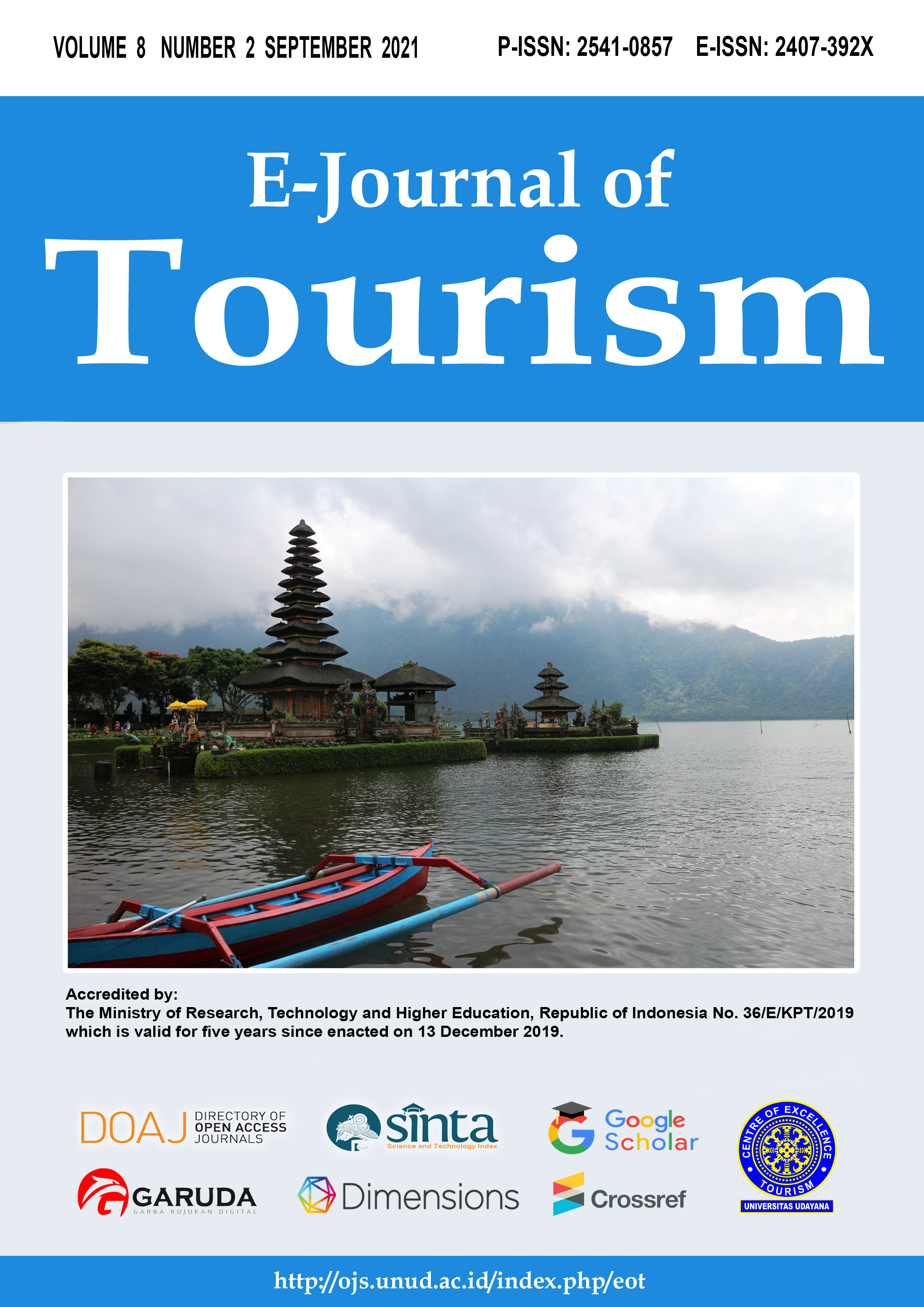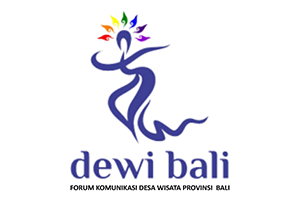The Effect of Eudamonic Value on Product Services, Satisfaction and Happiness of Foreign Tourists in Bali
Abstract
There are various factors that cause tourists’ happiness. There are tourists who are happy because of the influence of hedonic, spiritual, social, cultural, psychological, economic, and including eudaimonic values. Of all the factors that cause happiness, one of the important factors that need to be explored in determining the happiness of foreign tourists is the eudaimonic value. For tourists, this eudaimonic value is related to various aspects of tourism services in the context of achieving happiness. Despite this, the effect of this eudaimonic value in particular on service products, satisfaction and happiness of foreign tourists when traveling to Bali is not yet clear. Having the background, the objective of this study is to prove the effect of eudaimonic value on product services, examine the effect of eudaimonic value on tourist satisfaction, prove the effect of product service on tourist satisfaction, and examine the effect of tourist satisfaction on the psychological happiness of foreign tourists in Bali. This study took a sample of 171 respondents, namely foreign tourists who traveled to Bali. The analysis method uses SEM (Structural Equation Model). Based on the results of the analysis, the research findings are as follows: the value of eudaimonic has a positive and significant effect on the service product, the value of eudaimonic has a positive and significant effect on tourist satisfaction, the service product has a positive and significant effect on tourist satisfaction, and tourist satisfaction has a positive and significant effect on tourist satisfaction. tourist psychology well-being. Based on the results of the four tests, these findings can formulate a model of eudaimonic tourist happiness in Bali which is acronymized with the term MTES (Model of Tourists Eudaiminic Happiness). The conclusion of this research is MTES which covers the happiness of foreign tourists in Bali consisting of aspects of eudaimonic value, the service product, tourist satisfaction, and psychology of tourist well being. This study has limitations in terms of the number of test variables because there are still relatively many variables as determinants of the happiness of foreign tourists who travel to Bali. For this reason, further research is recommended to test with other foreign tourists variables such as the characteristics of foreign tourists, length of visit, and the desire to visit again to test the happiness of eudaimonic tourists in Bali.
Keywords: Eudaimonic, Service, Satisfaction, Happiness, Tourists
Downloads
References
Bali Post (2020) Satpol PP Badung Tegur Bule Tidur di Emper Toko. Available at: http://www.balipost.com/news/2020/02/22/105601/Satpol-PP-Badung-Tegur-Bule...html (Accessed: 22 February 2020).
Bauer, J. J., McAdams, D. P. and Pals, J. L. (2008) ‘Narrative identity and eudaimonic well-being’, Journal of happiness studies, 9(1), pp. 81–104.
Bimonte, S. and Faralla, V. (2012) ‘Tourist types and happiness a comparative study in Maremma, Italy’, Annals of Tourism Research, 39(4), pp. 1929–1950.
Chen, Y. and Li, X. R. (2018) ‘Does a happy destination bring you happiness? Evidence from Swiss inbound tourism’, Tourism Management, 65, pp. 256–266.
Churchill Jr, G. A. and Surprenant, C. (1982) ‘An investigation into the determinants of customer satisfaction’, Journal of marketing research, 19(4), pp. 491–504.
Corvo, P. (2011) ‘The pursuit of happiness and the globalized tourist’, Social indicators research, 102(1), pp. 93–97.
Drucker, P. (1999) The Practice of Management. London: Heinemann.
Fahy, J. and Jobber, D. (2006) Osnovimarketinga. Beograd: Data Status.
Fernández-Ballesteros, R., Zamarrón, M. D. and Ruiz, M. A. (2001) ‘The contribution of socio-demographic and psychosocial factors to life satisfaction’, Ageing & Society, 2, pp. 1–28.
Filep, S. (2008) ‘Measuring happiness: A new look at tourist satisfaction’, CAUTHE 2008: Tourism and Hospitality Research, Training and Practice;, p. 13.
Filep, S. and Deery, M. (2010) ‘Towards a picture of tourists’ happiness’, Tourism Analysis, 15(4), pp. 399–410.
Gerson, R. F. (1993) Measuring customer satisfaction. Thomson Crisp Learning.
Gillet, S., Schmitz, P. and Mitas, O. (2016) ‘The snap-happy tourist: The effects of photographing behavior on tourists’ happiness’, Journal of Hospitality & Tourism Research, 40(1), pp. 37–57.
Gong, T. and Yi, Y. (2018) ‘The effect of service quality on customer satisfaction, loyalty, and happiness in five Asian countries’, Psychology & Marketing, 35(6), pp. 427–442.
Hair, J. F. et al. (2006) Multivariate Data Analysis, New Jersey. Edited by sixth edition pearson Education. New Jersey: Prentice Hall.
Hair Jr, J. F. et al. (2014) ‘Partial least squares structural equation modeling (PLS-SEM): An emerging tool in business research’, European business review.
Hanh, T. N. (2005) Happiness: Essential mindfulness practices. Parallax Press.
Hill, N. (1996) Handbook of customer satisfaction measurement. Hampshire: Gower Publishing Limited.
Hill, N., Roche, G. and Allen, R. (2007) Customer satisfaction: the customer experience through the customer’s eyes. The Leadership Factor.
Huta, V. and Waterman, A. S. (2014) ‘Eudaimonia and its distinction from hedonia: Developing a classification and terminology for understanding conceptual and operational definitions’, Journal of Happiness Studies, 15(6), pp. 1425–1456.
Isen, A. M. et al. (1978) ‘Affect, accessibility of material in memory, and behavior: A cognitive loop?’, Journal of personality and social psychology, 36(1), p. 1.
Kotler, P. (1984) ‘Social marketing of health behavior’, in Marketing health behavior. Springer, pp. 23–39.
Kumparan.com (2020) Pasang Tenda di Pantai Kuta, Turis Denmark Diamankan Satpol PP. Available at: https://kumparan.com/kanalbali/pasang-tenda-di-pantai-kuta-turis-denmark-diamankan-satpol-pp-1snF9rHSuBK (Accessed: 22 February 2020).
Kusmarini, R. A., Sumarwan, U. and Simanjuntak, M. (2020) ‘The effect of atmosphere perception, perceived value, and hedonic value on consumer loyalty through the service quality of warunk upnormal’, Indonesian Journal of Business and Entrepreneurship (IJBE), 6(1), p. 53.
Lama, D. (2009) The art of happiness: A handbook for living. Penguin.
Lancaster, H. O. (1971) ‘The multiplicative definition of interaction’, Australian Journal of Statistics, 13(1), pp. 36–44.
Larivière, B. (2008) ‘Linking perceptual and behavioral customer metrics to multiperiod customer profitability: A comprehensive service-profit chain application’, Journal of Service Research, 11(1), pp. 3–21.
Layard, R. (2002) ‘Happiness: Has Social Science a Clue’, Lionel Robbins Memorial Lectures, 3, pp. 1–23.
Lee, J. et al. (2017) ‘An integrative model of the pursuit of happiness and the role of smart tourism technology: a case of international tourists in Seoul’, in Information and Communication Technologies in Tourism 2017. Springer, pp. 173–186.
Lee, W. and Jeong, C. (2019) ‘Beyond the correlation between tourist eudaimonic and hedonic experiences: necessary condition analysis’, Current Issues in Tourism, pp. 1–13.
Lickorish, L. J. and Jefferson, A. (1988) ‘Marketing Tourism: A Practical Guide’, Harlow: Longman.
Liu, K. (2013) ‘Happiness and tourism’, International Journal of Business and Social Science, 4(15).
Matteucci, X. and Filep, S. (2017) ‘Eudaimonic tourist experiences: The case of flamenco’, Leisure Studies, 36(1), pp. 39–52.
McCabe, S. and Johnson, S. (2013) ‘The happiness factor in tourism: Subjective well-being and social tourism’, Annals of Tourism Research, 41, pp. 42–65.
McDowall, S. (2010) ‘International tourist satisfaction and destination loyalty: Bangkok, Thailand’, Asia Pacific Journal of Tourism Research, 15(1), pp. 21–42.
Medic, S. and Middleton, V. T. C. (1973) ‘Product formulation in tourism. Tourism and Marketing, 13, 173-201’.
Nawijn, J. (2011) ‘Determinants of daily happiness on vacation’, Journal of Travel Research, 50(5), pp. 559–566.
Oliver Richard, L. (1997) Satisfaction: A behavioral perspective on the consumer. New York: ˈIrwin-McGraw-Hill.
Pearce, P. L. (2009) ‘The relationship between positive psychology and tourist behavior studies’, Tourism Analysis, 14(1), pp. 37–48.
Pizam, A., Neumann, Y. and Reichel, A. (1978) ‘Dimentions of tourist satisfaction with a destination area’, Annals of tourism Research, 5(3), pp. 314–322.
Prama, G. (2013) Simfoni di dalam Diri. Gramedia Pustaka Utama.
Rust, R. T. and Oliver, R. L. (1994) ‘Service quality: insights and managerial implications from the frontier’, Service quality: New directions in theory and practice, pp. 1–19.
Ryan, R. M. and Deci, E. L. (2001) ‘On Happiness and Human Potentials: A Review of Research on Hedonic and Eudaimonic Well-Being’, Annual Review of Psychology, 52(1), pp. 141–166. doi: 10.1146/annurev.psych.52.1.141.
Ryff, C. D. (1995) ‘Psychological well-being in adult life’, Current directions in psychological science, 4(4), pp. 99–104.
Ryu, K., Lee, H. and Kim, W. G. (2012) ‘The influence of the quality of the physical environment, food, and service on restaurant image, customer perceived value, customer satisfaction, and behavioral intentions’, International journal of contemporary hospitality management.
Sasser, W. E., Olsen, R. P. and Wyckoff, D. D. (1978) Management of service operations: Text, cases, and readings. Allyn and Bacon.
Sherman, E., Mathur, A. and Smith, R. B. (1997) ‘Store environment and consumer purchase behavior: mediating role of consumer emotions’, Psychology & Marketing, 14(4), pp. 361–378.
Smith, M. K. and Diekmann, A. (2017) ‘Tourism and Well-being’, Annals of Tourism Research, 66, pp. 1–13.
Smith, S. L. J. (1994) ‘The tourism product’, Annals of tourism research, 21(3), pp. 582–595.
Steger, M. F., Kashdan, T. B. and Oishi, S. (2008) ‘Being good by doing good: Daily eudaimonic activity and well-being’, Journal of Research in Personality, 42(1), pp. 22–42.
Stone, P. (2012) ‘Experiencing tourism, experiencing happiness?’
Swinyard, W. R. (1993) ‘The effects of mood, involvement, and quality of store experience on shopping intentions’, Journal of consumer research, 20(2), pp. 271–280.
Tribuntravel.com (2019) 12 Kelakuan Turis Asing di Bali yang Meresahkan, Menjambret hingga Tendang Pengendara. Available at: https://travel.tribunnews.com/2019/12/31/12-kelakuan-turis-asing-di-bali-yang-meresahkan-menjambret-hingga-tendang-pengendara (Accessed: 14 March 2020).
Vavra, G. T. (1997) Improving your measurement of customer satisfaction : a guide to creating, conducting, analyzing, and reporting customer satisfaction measurement programs. Milwaukee, Wis: ASQ Quality Press.
Xiong, K. (2011) ‘Research on Tourist Happiness: Perspectives from Psychology and Ethics’. Xi’an: Shaanxi Normal University, 2011.[亢雄. 基于伦理与心理视角的旅游者幸福 ….
Zhong, Y. and Moon, H. C. (2020) ‘What drives customer satisfaction, loyalty, and happiness in fast-food restaurants in China? perceived price, service quality, food quality, physical environment quality, and the moderating role of gender’, Foods, 9(4), p. 460.

This work is licensed under a Creative Commons Attribution 4.0 International License.
The copyright of the received article shall be assigned to the journal as the publisher of the journal. The intended copyright includes the right to publish the article in various forms (including reprints). The journal maintains the publishing rights to the published articles.




















